In this WP, data analysis, simulations and experiments will be employed to the following ends:
- to carry out a careful comparative evaluation of the wall-based active control techniques, with particular emphasis on those relying on spanwise forcing, and to quantify their performance in terms of drag reduction and, most important, their potential for net energetic savings;
- to advance the state-of-the-art in experimental testing of the abovementioned control strategies; this will include introducing and characterizing innovative actuators as well as improving, extending and optimizing existing ones;
- to progress in the design of innovative passive control strategies inspired by active spanwise forcing.
The data acquired in this WP, together with the knowledge gained in WP3WP4, will be passed down to other partners, especially in WP5WP5 where calibration of the turbulence models will rely on information gathered here.
In the first strand of WP2WP3 , the whole range of active control techniques falling under the heading of spanwise forcing, which is the most effective in producing drag reduction based on in-plane wall forcing, will be compared with a view to identify the best in terms not only of drag reduction, but also of net energy savings. Although most of the considered techniques are not new, the information available in the literature is often limited to drag reduction only, while the primary motivation for turbulent skin-friction drag reduction technologies resides in their potential net savings (of fuel, emissions, money, etc). Even those few studies that go beyond simply reporting “percentage change of friction coefficient” and provide information on the energy cost of the control techniques yield figures which are unfortunately not directly comparable to each other. A study purposely designed to identify the technique(s) with the largest potential, both in internal and external flows, is therefore in order, and will be carried out here.
In the second strand of the WP , the activity will focus on the experimental implementation of the best techniques as ranked above. This will include the execution of wind tunnel experiments, as well as the optimization by numerical means of the design and operation of the control systems in the experimental tests. Moreover, novel actuator types will be introduced, characterized and used. Plasma-based actuators will be tested in a variety of configurations, with the aid of optimization techniques used to identify their best operating conditions. Numerical simulations will be used to design the layout of the actuators in such a way that the adverse effect due to the finiteness of the electrodes does not adversely affect the end result. Novel actuator types for spanwise forcing based on suitably arranged synthetic jets will be numerically studied, and rotating devices deployed at the wall to produce an effective spanwise forcing will be tested experimentally.
In the third and last strand of the WP , numerical studies will be used to assess the drag reduction potential of innovative passive techniques which are inspired by active spanwise-forcing concepts. These techniques basically consist in a smart distribution of wall roughness which is expected to reduce friction below the level of a perfectly flat surface. Such smart roughness are deemed to provide less drag reduction compared to their active counterparts; however, the complete lack of energetic cost, together with their relative simplicity and reliability make them interestingly attractive candidates for aeronautical applications.
